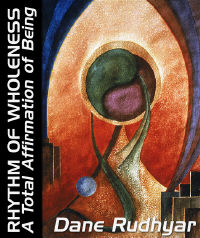 |
| Home | Bio | Art | Music | Literature | Civilization & Culture | Philosophy of Wholeness | Theosophy & Spirituality | Astrology |

RHYTHM OF WHOLENESS A Total Affirmation of Being by Dane Rudhyar, 1983 CONTENTS PROLOGUE PART ONE The Philosophy of Operative Wholeness 1. Prelude to a New Interpretation of Reality 2. The Search for Spiritual Security: The One, the Whole, and Wholeness 3. The Movement of Wholeness PART TWO The Cycle of Being 4. The Structure of the Cycle of Being 5. The Four Crucial Phases of the Cycle of Being 6. The Inevitability of Success and Failure 7. Spirit and Mind PART THREE The Cycle of Man 8. Constitution of Man - The Physical and Psychic Bodies 9. Constitution of Man - The Spiritual Entity and the Higher Mind 10. The Structure and Transformation of the Total Person 11. The Cyclic Process of Spiritual Embodiment Page 1 Page 2 Page 3 Page 4 PART FOUR In The Spirit of Wholeness 12. The Principle of Holarchy and the Interplay of Horizontal and Vertical Relationships 13. Transpersonal Activity versus Mediumship 14. Rites of Passage EPILOGUE |

CHAPTER ELEVEN
The Cyclic Process of Spiritual Embodiment - 4 The Cycle of Man and its pancultural fulfillment The process I have outlined above deals only with a single spiritual Quality — only one of a myriad of aspects of the creative Word (Logos) — and a single series of personalities magnetically drawn to this single aspect. Billions of these processes are now at work, their earliest phases having taken place in societies forgotten long ago. In most of them, a person now living is a rather narrowly circumscribed system of organization dominated by biological drives, by the assumptions and imperatives of his or her culture, and by the desires, emotions, and expectations of an insecure, constantly shifting center of gravity, the ego; and previous personalities in the series probably felt, acted, and thought in much the same way, at a similar level of consciousness in various cultures. Instead of focusing attention upon these series of persons, each attracted (mostly unconsciously) by a particular spiritual Quality, one can as well think primarily of the gradual evolution of cultures through the millions of years mankind has been active on earth. Each culture is also a whole, a system of organization giving a particular structure and character to a collectivity of human beings, a society. This structure concretizes an archetype of interpersonal and social relatedness, according to the possibilities of a region of the biosphere and the need of the human species at a particular stage of the planet's evolution. Cultures are systems of collective living, which gradually form, mature, and disintegrate either rapidly or through a slow process of senescence and institutional sclerosis. They usually leave some kind of mental or perhaps spiritual harvest to future societies, and all these harvests contribute to the development of the earth's noosphere — that is, the planetary Mind. But even this Mind is not the ultimate reality of the planet. A planetary spiritual realm corresponds to the spiritual entity in the total organization of a human being. To think of the whole earth as a system of organization encompassing all levels of activity and consciousness, from the most material to the most spiritual, may be difficult for people whose conception of "being" has been limited by Western traditions. However, there is no longer any reason to remain blind to the amazingly well-organized interactions integrating every component of the planet into a single organism, able to maintain the balance of its functions, heal, and transform itself. This planetary organism has a physical-material basis of rocks, minerals, water, and soil; and a biosphere gradually develops on it. As vegetable and animal species evolve and become increasingly interrelated and interdependent, ecosystems take form and at least rudimentary forms of collective psychism evolve in them, especially as animal, and later primitive human societies, appear. As the contents of this psychic realm become ever more conscious and mental through the operations of human cultures and socioreligious institutions, the planetary Mind or noosphere becomes a relatively independent field for which the archetypes of many cultures provide structures relevant to the needs of human collectivities. The highest levels of this noosphere can be considered the base of operation from which planetary or cosmic forces radiate into the whole earth. They may correspond to what Sri Aurobindo called the "overmind," beyond which he envisions a "supermind" referring to the planetary dharma (or supreme "Truth") of humanity. From such a point of view, the planetary function of humanity as a whole is to develop a network of integrated mental consciousness progressively filling the noosphere with the harvest of significant and revealing experiences left by every culture. Archetypally, Man is the being in charge of giving meaning to every activity within the planetary organism — meaning in relation to the whole; meaning which includes much more than sense-data and rationalistic interpretations. Ultimately, this meaning includes a full awareness of the original archetype structuring the various activities within the entire planet — and much more than the archetypal structure. The "omega-state" is not only a perfect realization of the "alpha-creative" release. At least in principle, it also includes a plus factor which is essentially unpredictable — the spiritual harvest of meaning produced by the magic of relatedness, by the unceasing interaction between all existents within the planetary field. The factor of interrelatedness should never be ignored. It is ignored if one believes that a single individual alone can reach a state of being identical to the state which the Communion of co-conscious and co-active perfected human beings (the Pleroma) can attain at the close of a great planetary cycle. Inasmuch as a self-conscious individual human being is a whole, he or she can experience Wholeness and be "illumined" or "initiated" in terms of the "divine Marriage" mentioned above. But the illumination an individual can receive is always colored by the particularity of the spiritual Quality (the Letter of the creative Word) which constitutes his or her spiritual identity. At the level of any particular being, light is colored; or perhaps we should speak of luminescence rather than light. A red radiation may be extremely intense, but it docs not contain the entire spectrum of solar light human beings consider "white." Modern students of esoteric philosophy (though evidently it is no longer "esoteric"!) speak of seven "cosmic Rays" emanating from the originating release of divine power; and such a sevenfold differentiation of a primordial creative release seems almost universally accepted by esoteric philosophies (though in some instances only five streams of power are mentioned publicly). If the one creative release beginning the cycle divides at once into seven streams of power, it is logical to expect that at the close of the cycle the complex interrelatedness of seven groups of perfected human beings is needed to produce the synthesis of meanings out of which the one white Light would emerge as a supreme final realization, balancing, as it were, the primordial unity of the creative Word. The problem implied in the preceding paragraphs is encountered at every level of existence, because at every level an organized system — an existent — is both a whole and a participant in the field of activity (and also in the consciousness) of a greater, more encompassing whole. Every whole is a manifestation of Wholeness, but only at the level at which it actually operates. The greater whole in which its activity takes place contains many other existential units that are also wholes, all of which perform only limited functions in the organism of the greater whole. As every whole is therefore at the same time whole and part, it may identify itself either with its own wholeness — with its own sense of being a complete system — or with its "partness," that is, with the function it performs not only in but also for the greater whole. Every whole that has reached the human stage of self-consciousness theoretically can have an experience of Wholeness relative to the level at which it primarily functions. Yet the experience of Wholeness at the biological level has not the same scope and quality as the experience of Wholeness at the sociocultural or personal level. A human body may experience Wholeness as health and vitality, in terms of the quality defining yet limiting everything that is born and has matured in the earth's biosphere. At the level of personhood. Wholeness is experienced in terms of sociocultural values. The experience of Wholeness is thus qualified by the dynamic character and intensity of the activity and the consciousness of the experiencing whole. In this sense it is "colored" by the place the experiencer occupies in the entire cycle of being. If the whole reaching its cyclic climax results from the integration of a spiritual entity and an individual person perfectly attuned to it, the experience of Wholeness includes the spiritual harvest of a long series of personalities brought to a focus in the concluding "divine Marriage." The quality of the experience could be called "panpersonal" as well as spiritual. At the level of the Pleroma, it presumably is "panhuman" and planetary; all "Rays" (and sub-Rays) and the harvest of all the cultures of human evolution contribute to it. Thus one can symbolize it as perfect, all-inclusive "whiteness" — hence the symbolic appellation, "White Lodge." In the ultimate moment of planetary consummation (the symbolic "Last Day"), the whole earth should experience planetary Wholeness in its fullness. Beyond planetary Wholeness one can envision an experience of heliocosmic Wholeness in which the entire solar system (helios=sun, cosmos=all-inclusive system) would fully experience both its unity and its cosmic meaning. The human mind with its passion for reducing every possibility of experience to some quantitative value, when faced with the logical impossibility of placing an end to the series of ever more encompassing wholes, can only take cover under the negative, pseudo-idea of infinity — just as the mystic speaks of timelessness when, for a moment having paralyzed in his consciousness the operation of the principle of Multiplicity, he or she experiences an ecstasy of oneness. For the "mind of wholeness" all great experiences are both all-inclusive and qualitative. Wholeness is. At whatever level it is experienced, it is unquantitized Wholeness — neither small nor vast, because satisfied in being what it is, filled with the serenity of plenitude of being, illumined with the peace that glows with the "light" of a harmony in which all motions are balanced. Where such a plenitude and such a perfection of polarized movements exist, there is neither small nor large, neither time nor infinity — only Wholeness, undefinable because the defining mind is totally absorbed in the immeasurable peace of totally "being." By permission of Leyla Rudhyar Hill Copyright © 1983 by Dane Rudhyar All Rights Reserved.  Web design and all data, text and graphics appearing on this site are protected by US and International Copyright and are not to be reproduced, distributed, circulated, offered for sale, or given away, in any form, by any means, electronic or conventional. See Notices for full copyright statement and conditions of use. Web design copyright © 2000-2004 by Michael R. Meyer. All Rights Reserved. |
 |